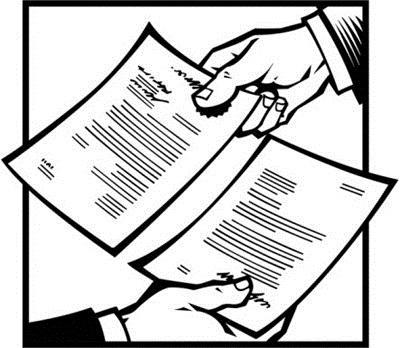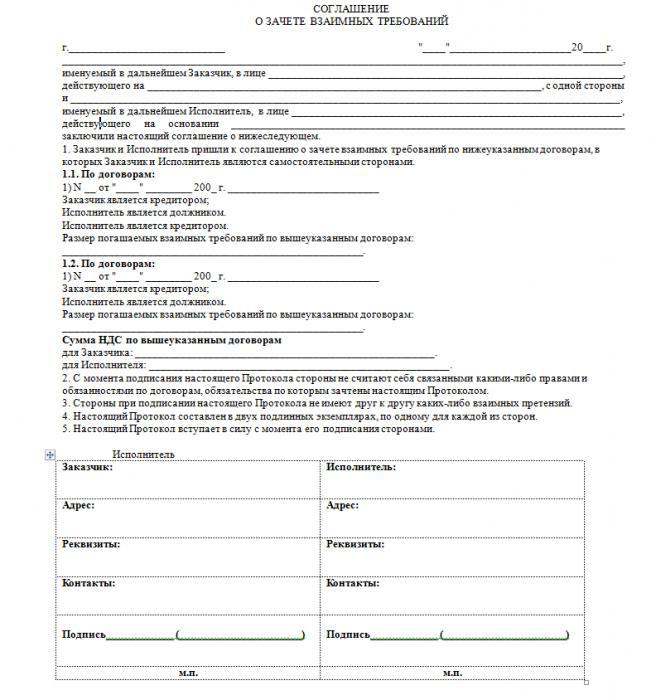Let's look at how to draw up a netting agreement correctly, under what conditions it cannot be done, what are the consequences for those using a simplified taxation system and how to calculate VAT.
What is netting
Offsetting under various agreements is a procedure in which the obligations of an organization are deemed fulfilled through the execution of such services. That is, you ordered a certain economic action from the client’s organization, he acted as an executor, performed the service and transferred it. But for some reason you did not pay it in cash. Then your client acted as a customer, you performed economically similar work for him. At the time when the time has come for the demand for payment, you have drawn up a service offset agreement. On the way out - no one owes anything to anyone. This is the meaning, in simple terms. At the same time, note that the obligations of firms must be uniform. They must be due date of payment, if it is specified in the contract (a sample of the netting agreement will be given below), or the date of payment is considered the moment of payment obligation.

Some good examples
Imagine you are renting an office in a building. The lease has come to an end, and you decided not to renew it. At the same time, the premises were repaired, a split system was installed, and parquet floors were laid. All this was done at the expense of your company with the consent of the owner of the building. After the termination of the lease, either the owner is obliged to reimburse your repair costs, or the payment by offset in the contract of part of the lease payments may be prescribed.
The contractor claimed money from the customer for the work performed. However, he had a loan at the bank, the guarantor was this same customer. Since the contractor did not pay interest on the use of money, the customer paid them. As a result, it is possible to offset the cost of work and the amount of loan funds paid off.
In the task, we have a borrower and a debtor, as well as a person who owes some money to the first debtor. They have no response requirements. That is, the chain is vertical. The first person borrowed money to the second, the second to the third. There can be no talk of any netting agreement, since the opponent has no counterclaims.

Sample netting agreement
Offsetting requires special clearance. The netting agreement must contain all the details and amounts of claims that are its subject. But first you need to provide all receipts, invoices, acts of work performed and checks, which are proof of the onset of obligations between the parties. You can view a sample netting agreement below.

Need to draw up Act of reconciliation, since offsetting can cover not only the entire amount of the debt in full, but also partially repay it. This is necessary in order to exclude the further occurrence of disagreements. If the amount set out for offsetting is lower than counterclaims, the transactions for which the due date has come earlier are considered satisfied. To start the process, it is enough to declare one of the parties to the agreement to the other in any form. The notification is printed in two copies, on one of them the partner must put his visa on receipt of the information letter and send back to the initiator. After the conclusion of the contract, it is necessary to draw up an act.It is the primary accounting document and confirms the completion of this operation. It should also indicate the specific obligations deducted for the offset, the dates of their commitments, payment and amount. Each copy must be signed by the director and chief accountant of both parties and stamps of company seals.

Offset VAT
When drawing up the act, the sum of input and output VAT should be prescribed in the corresponding columns of the form. It must be paid by money transfer to the bank in the reporting period when the netting act was signed.
However, tax authorities often equate a netting operation with a barter and require an exclusive input VAT to be taken into account by the supplier. This is not acceptable under the law. If you have received such a claim, feel free to contact the arbitration. Recently, such cases are most often resolved in favor of the tax payer. By the way, net offsets are not exempt from tax deductions.

When netting is prohibited
If the payment deadline has not yet expired, no offsetting agreement can be signed. Clearance should be carried out only on completed transactions with expired cash operations. It is also impossible to draw up such an agreement if the limitation period for the obligation has expired. There are several conditions that are contrary to the conclusion of such an agreement. These include questions about life-time maintenance, payment of alimony, cases of damage or harm to human health.
Offsetting cannot be carried out if a bankruptcy process is initiated to one of the parties. There may be other points specified directly in the contract, as well as those made by the state. For example, the Civil Code provides for the impossibility of making such a claim if no contribution has been made to the authorized capital. The same system applies to shareholders in joint stock companies.

Offsetting with a simplified tax system
Entrepreneurs using a simplified tax system should be most attentive to such transactions. Its result will be entered in the "income" column, which means it will increase the amount of taxable amount. Tax authorities often insist on offsetting so that open transactions are closed faster, but the manager has the right to decide whether to conduct them or not. Know and exercise your rights to avoid unnecessary costs in the process of economic activity.

Act and netting agreement
How to register offsets in the contract, we will consider in this paragraph. For the entry into force of the netting process, a statement on the one hand is sufficient. At the same time, the document (the model of the netting agreement is given above) may contain one single entry: "In accordance with the terms of this agreement, the termination of obligations in accordance with Article 410 of the Civil Code of the Russian Federation by offsetting a uniform counterclaim is allowed." In the future, when the necessary situation occurs, an act is drawn up. It must necessarily contain the following items: name, date and place of preparation of the document, name of the organization that was involved in the preparation, measuring instruments in kind and in money terms, links to source documents, due to which the obligation arose, information on it, total amount offsets, last name, first name and patronymic of officials, namely the manager (director, general director) and chief accountant, as well as a print of the seal. The act is drawn up in duplicate, copies of source documents are attached to it.



